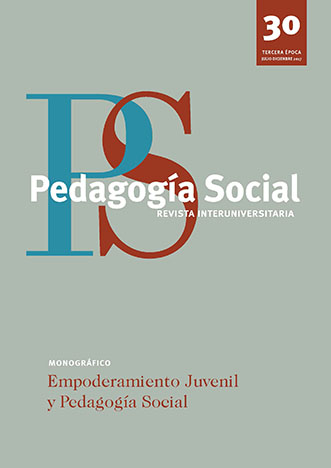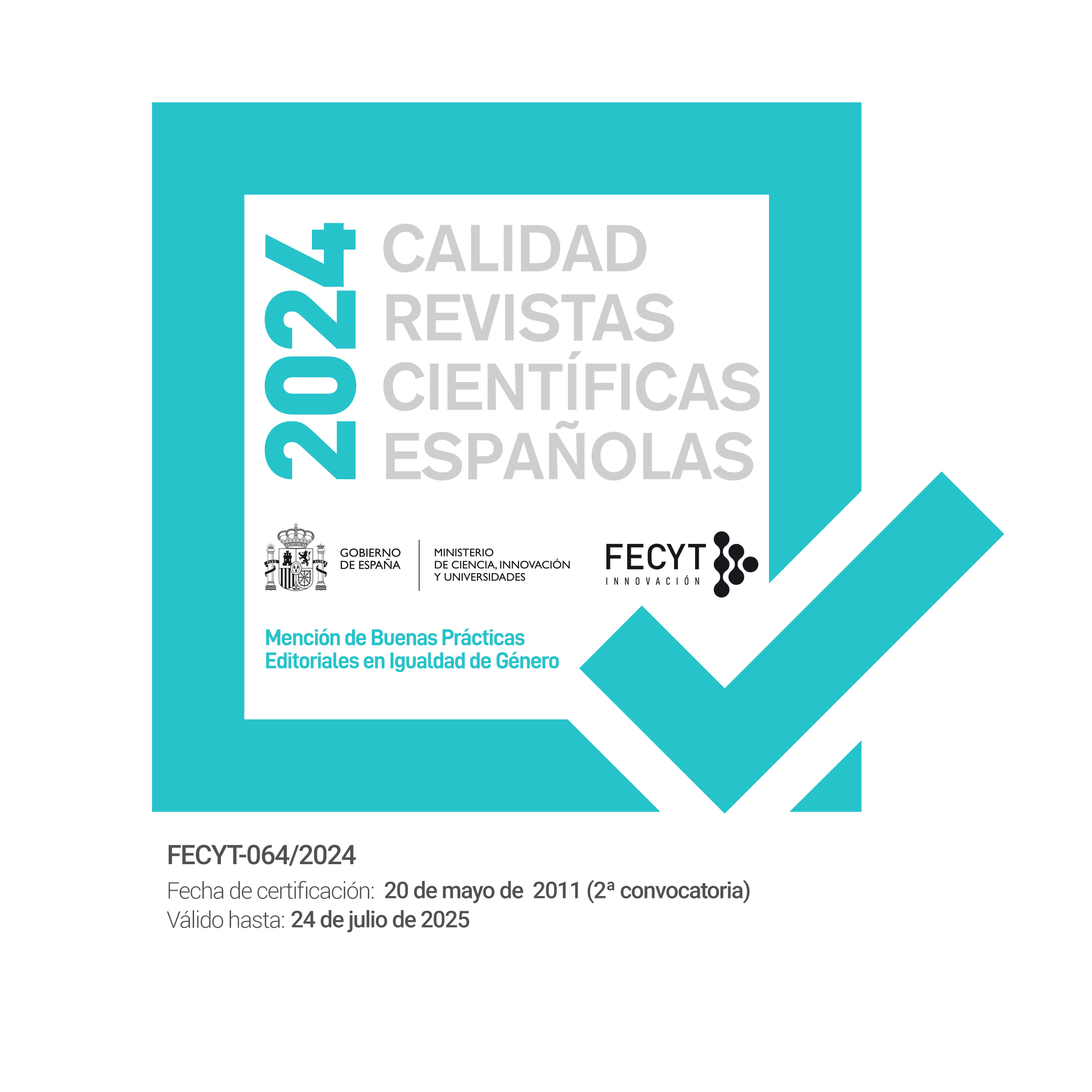Perceção dos jovens sobre os espaços e momentos no seu processo de capacitação. Uma aproximação quantitativa
DOI:
https://doi.org/10.7179/PSRI_2017.30.04Palavras-chave:
Capacitação juvenil, espaços capacitantes, incidentes críticos, etapas vitaisResumo
A voz dos jovens não foi tida em conta na conceptualização da capacitação e nos estudos sobre esta. O presente artigo contribui para a investigação de espaços e momentos-chave no processo de capacitação juvenil a partir da própria vivência na primeira pessoa de 890 jovens. Através de uma aproximação quantitativa, estuda-se como diferentes espaços da vida quotidiana contribuem para o desenvolvimento de competências e como estes permitem aplicá-las. Identificam-se vivências que os jovens percebem como altamente capacitantes e estuda-se a relação da capacitação com as diferentes etapas vitais. Os resultados apontam para o facto de os espaços onde os jovens mais se capacitam serem os da educação formal e não formal e os ambientes laborais. Também visualizam a importância da emancipação e as experiências vitais que requerem uma atitude de superação pessoal. Por fim, os resultados propiciam evidências e contribuem para o debate e a reflexão sobre a capacitação juvenil, tanto para as investigações futuras como para otimizar as intervenções no trabalho com jovens e na conceção e implementação de políticas de juventude
Downloads
Referências
Blanchet-Cohen, N., & Brunson, L. (2014). Creating Settings for Youth Empowerment and Leadership: An Ecological Perspective, Child & Youth Services, 35 (3), 216-236, DOI: 10.1080/0145935X.2014.938735.
Boluijt, B., & de Graaf, L. J. (2010). Preaching empowerment, practicing participation: The use of empowerment and citizen participation in Dutch local democracies. Onbekend: Tilburgse School voor Politiek en Bestuur (TSPB).
Fetterman, D. M., & Wandersman, A. (2007). Empowerment Evaluation: Yesterday, Today, and Tomorrow. American Journal of Evaluation 28 (2), 179-98. doi:10.1177/1098214007301350.
Hennink, M., Kiiti, N., Pillinger, M., & Jayakaran, R. (2012). Defining empowerment: perspectives from international development organisations. Development in Practice, 22 (2), 202-215. Holte-McKenzie, M.; Forde, S. & Theobald, S. (2006). Development of a Participatory Monitoring and Evaluation Strategy. Evaluation and program planning, 29 (4), 365-76.
Jennings, L. B., Parra-Medina, D. M., Hilfinger Messias, D. K., & McLoughlin, K. (2008). Toward a critical social theory of youth empowerment. Journal of Community Practice, 14, 31-55.
Kaplan, S. J., L. Skolnik, L., & Turnbull, A. (2009). Enhancing the Empowerment of Youth in Foster Care: Supportive Services. Child Welfare, 88 (1), 133-161.
Kelly, C., & Carson, E. (2012). The Youth Activist Forum: Forging a Rare, Disability-Positive Space That Empowers Youth. Journal of Youth Studies 15 (8), 1089-1106. doi:10.1080/13676261.2012.693595.
Masa, M. (2009). Adolescentes en Euskadi. Una aproximación desde el empoderamiento. Vitoria-Gasteiz: Emakunde. Instituto Vasco de la Mujer.
Mchale, S. M., Dotterer, A., & Kim, J.-Y. (2009). An ecological perspective on the Media and Youth Development. American Behavioral Scientist, 52 (8), 1186-1203.
Morrissey, J. (2000). Indicators of Citizen Participation: Lessons from Learning Teams in Rural EZ/EC Communities. Community Development Journal, 35 (1), 59-74.
Morton, M. H., & Montgomery, P. (2013). Youth Empowerment Programs for Improving Adolescents’ Self-Efficacy and Self-Esteem: A Systematic Review. Research on Social Work Practice, 23 (1), 22-33.
Mosedale, S. (2003). “Towards a framework for assessing empowerment”. Paper presented at the Conference New Directions in Impact Assessment for Development. Methods and Practice, Manchester, November 24-25.
Nolas, S-M. (2014). Exploring Young People’s and Youth Workers’ Experiences of Spaces for ‘youth Development’: Creating Cultures of Participation. Journal of Youth Studies, 17 (1), 26-41. Doi:10.1080/13676261.2013.793789.
Observatori Català de la Joventut. (2016). Situació laboral de les persones joves a Catalunya. Generalitat de Catalunya. Departament de Treball, Afers Socials i Famílies. Direcció General de Joventut.
Omar, A., Paris, L., Delgado, H. U., Ameida da Silva, S. E., & Aguiar de Souza, M. (2011). Un modelo explicativo de resiliencia en jóvenes y adolescentes. Psicologia Em Estudo, 16 (2), 269-277.
Pearrow, M. M. (2011). Opportunity for Unity Collaborative: Building Healthy Communities by Empowering Young Adults. Community Development 42 (2), 167-80.
Peterson, N. A. (2014). Empowerment theory: clarifying the nature of higher-order multidimensional constructs. American Journal of Community Psychology 53 (1-2), 96-108.
Peterson, N. A., Peterson, C. H., Agre, L., Christens, B. D., & Morton, C. M. (2011). Measuring youth empowerment: validation of a Sociopolitical Control Scale for Youth in an urban community context. Journal of Community Psychology, 39 (5): 592-605. Doi:10.1002/jcop.20456.
Pick, S., Sirkin, J., Ortega, I., Osorio, P., Martínez, R., Xocolotzin, U., & Givaudan, M. (2007). Escala Para Medir Agencia Personal y Empoderamiento (ESAGE). Revista Interamericana de Psicología, 41 (3), 295-304.
Pineda-Herrro, P., Agud-Morell, I., Ciraso-Cali, A., & Soler-Masó, P. (en revisión). In their own words: Elements of Youth Empowerment in Spain. Journal of Youth Studies.
Pineda-Herrero, P., Agud-Morell, I., & Núñez, H. (2015). Empoderamiento juvenil: conceptos y significados del empoderamiento para sus protagonistas. IV Congreso Iberoamericano de Pedagogía Social. Ciudad de Puebla, México.
Russell, S. T., Muraco, A., Subramaniam, A., & Laub, C. (2009). Youth empowerment and high school gay-straight alliances. Journal of Youth and Adolescence, 38 (7), 891-903. Doi:10.1007/s10964-008-9382-8.
Sathar, Z.A., & Kazi, S. 1997. Women’s Autonomy, Livelihood & Fertility: A Study of Rural Punjab. Islamabad: Instituto Pakistan Institute of Development Economics.
Soler, P., Trilla, J., Jiménez-Morales, M., & Úcar, X. (2017). La construcción de un modelo educativo del empoderamiento juvenil: espacios, momentos y procesos, Pedagogía Social. Revista Interuniverstiaria, 30, 25-40. DOI:10.7179/ PSRI_2017.30.02.
Stolte, L. C., Isenbarger, M., & Cohen, A. K. (2014). Measuring Civic Engagement Processes and Youth Civic Empowerment in the Classroom: The CIVVICS Observation Tool, The Clearing House: A Journal of Educational Strategies, Issues and Ideas, 87:1, 44-51, DOI: 10.1080/00098655.2013.842531.
Tromp, M. (2007). A system of empowerment indicators for a corporate work environment. Johannesburg: University of Johannesburg.
Úcar Martínez, X., Jiménez-Morales, M., Soler Masó, P., & Trilla, J. (2016). Exploring the conceptualitzation and research of empowerment in the field of youth. International Journal of Adolescence and Youth. Doi: http://dx.doi.org/10.10 80/02673843.2016.1209120
Wagaman, M. A. (2011). Social Empathy as a Framework for Adolescent Empowerment. Journal of Social Service Research 37 (3), 278-293.
Wright, K. (2010). “Giving Voice’ to Youths in Out-of-Home Placements. Journal of Human Behavior in the Social Envi-ronment, 20 (3), 335-348.
Ficheiros Adicionais
Publicado
Como Citar
Edição
Secção
Licença
Direitos de Autor (c) 2017 Pedagogía Social. Revista Interuniversitaria

Este trabalho encontra-se publicado com a Licença Internacional Creative Commons Atribuição-NãoComercial-CompartilhaIgual 4.0.
Derechos de reproducción y archivo
La versión publicada de los artículos podrá ser autoarchivada por sus autores en repositorios institucionales y temáticos de acceso abierto. No obstante la reutilización total o parcial de los mismos en nuevos trabajos o publicaciones deberá ser autorizada por Pedagogía Social. Revista Interuniversitaria.
Los trabajos publicados deberán ser citados incluyendo el título de la Revista, Pedagogía Social. Revista Interuniversitaria, nº, páginas y año de publicación.
Responsabilidades éticas
Pedagogía Social. Revista Interuniversitaria no acepta material publicado anteriormente en otros documentos. Los/as autores/as son responsables de obtener los permisos oportunos para reproducir parcialmente material de otras publicaciones y citar correctamente su procedencia. Estos permisos deben solicitarse tanto al autor/a como a la editorial que ha publicado dicho material.
Es obligación de Pedagogía Social. Revista Interuniversitaria detectar y denunciar prácticas fraudulentas.
En la lista de autores/as firmantes deben figurar únicamente aquellas personas que han contribuido intelectualmente al desarrollo del trabajo.
La revista espera que los/as autores/as declaren cualquier asociación comercial que pueda suponer un conflicto de intereses en conexión con el artículo remitido.
Los autores deben mencionar en el manuscrito, preferentemente en el apartado del método, que los procedimientos utilizados en los muestreos y controles han sido realizados tras la obtención de consentimiento informado.
La revista no utilizará ninguno de los trabajos recibidos con otro fin que no sea el de los objetivos descritos en estas normas.
Aviso de derechos de autor/a
© Pedagogía Social. Revista Interuniversitaria. Los originales publicados en las ediciones impresa y electrónica de esta Revista son propiedad del Pedagogía Social. Revista Interuniversitaria, siendo necesario citar la procedencia en cualquier reproducción parcial o total.
Salvo indicación contraria, todos los contenidos de la edición electrónica se distribuyen bajo una licencia de uso y distribución “Creative Commons Reconocimiento-No Comercial 3.0 España” (CC-by-nc). Puede consultar desde aquí la versión informativa y el texto legal de la licencia. Esta circunstancia ha de hacerse constar expresamente de esta forma cuando sea necesario.






